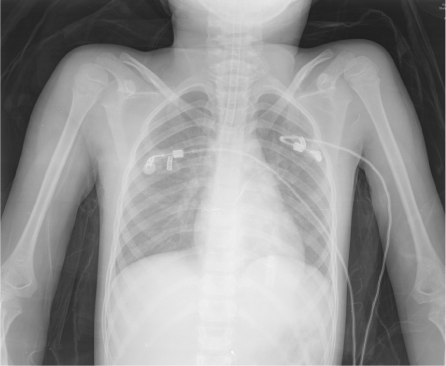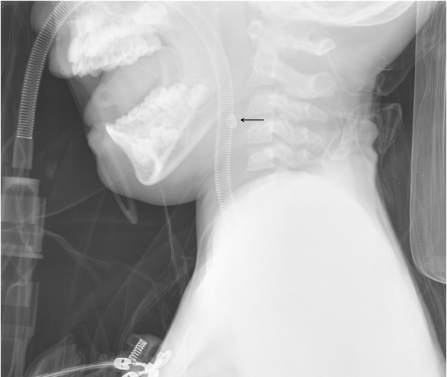J Dent Anesth Pain Med.
2016 Mar;16(1):61-65. 10.17245/jdapm.2016.16.1.61.
Displacement of deciduous tooth into hypopharynx due to endotracheal intubation
- Affiliations
-
- 1Department of Oral and Maxillofacial Surgery, National Health Insurance Service Ilsan Hospital, Goyang, Korea.
- 2Department of Otorhinolaryngology, National Health Insurance Service Ilsan Hospital, Goyang, Korea. manbang5@naver.com
- KMID: 2308767
- DOI: http://doi.org/10.17245/jdapm.2016.16.1.61
Abstract
- Intubation may lead to several dental complications. Furthermore, a tooth damaged during intubation may be subsequently dislocated. In the present case, the upper primary incisor was avulsed during intubation and, unbeknownst to the anesthesiologist, displaced to the larynx. We report here on the findings and indicate appropriate treatment. Intubation for general anesthesia in children can result in tooth damage and/or dislocation of primary teeth with subsequent root resorption. Prevention is key, and thus it is critical to evaluate the patient's dental status before and after intubation. Furthermore, anesthesiologists and dentists should pay close attention to this risk to prevent any avulsed, dislocated, or otherwise displaced teeth from remaining undetected and subsequently causing serious complications.
Keyword
MeSH Terms
Figure
Reference
-
1. Chadwick RG, Lindsay SM. Dental injuries during general anaesthesia. Br Dent J. 1996; 180:255–258.
Article2. Warner ME, Benenfeld SM, Warner MA, Schroeder DR, Maxson PM. Perianesthetic dental injuries: frequency, outcomes, and risk factors. Anesthesiology. 1999; 90:1302–1305.
Article3. Adolphs N, Kessler B, von Heymann C, Achterberg E, Spies C, Menneking H, et al. Dentoalveolar injury related to general anaesthesia: a 14 years review and a statement from the surgical point of view based on a retrospective analysis of the documentation of a university hospital. Dent Traumatol. 2011; 27:10–14.
Article4. Casap N, Alterman M, Lieberman S, Zeltser R. Enigma of missing teeth in maxillofacial trauma. J Oral Maxillofac Surg. 2011; 69:1421–1429.
Article5. Tammara A, Reed RM, Verceles AC. A missing tooth after intubation. BMJ Case Rep. 2014; 2014.
Article6. Chidyllo SA, Zukaitis JA. Dental examinations prior to elective surgery under anesthesia. N Y State Dent J. 1990; 56:69–70.7. Boye TA, Orr RL, Majdneya J. Spontaneous exhalation of an inhaled tooth in a child: a case report. Int J Oral Maxillofac Surg. 2009; 38:1333–1335.
Article8. Lindemeyer RG, Rashewsky SE, Louie PJ, Schleelein L. Anesthetic and dental management of a child with IMAGe syndrome. Anesth Prog. 2014; 61:165–168.
Article9. Walker RW. Pulmonary aspiration in pediatric anesthetic practice in the UK: a prospective survey of specialist pediatric centers over a one-year period. Paediatr Anaesth. 2013; 23:702–711.
Article10. Monaca E, Fock N, Doehn M, Wappler F. The effectiveness of preformed tooth protectors during endotracheal intubation: an upper jaw model. Anesth Analg. 2007; 105:1326–1332. table of contents.
Article11. Rabiner JE, Auerbach M, Avner JR, Daswani D, Khine H. Comparison of GlideScope Videolaryngoscopy to Direct Laryngoscopy for Intubation of a Pediatric Simulator by Novice Physicians. Emerg Med Int. 2013; 2013:407547.
Article12. Kim HJ, Kim JT, Kim HS, Kim CS. A comparison of GlideScope videolaryngoscopy with direct laryngoscopy for nasotracheal intubation in children. Paediatr Anaesth. 2011; 21:1165–1166.
Article13. Moon YJ, Kim J, Seo DW, Kim JW, Jung HW, Suk EH, et al. Endotracheal intubation by inexperienced trainees using the Clarus Video System: learning curve and orodental trauma perspectives. J Dent Anesth Pain Med. 2015; 15:207–212.
Article14. Lee KH, You TM, Park W, Lee SH, Jung BY, Pang NS, et al. Protective dental splint for oroendotracheal intubation: experience of 202 cases. J Dent Anesth Pain Med. 2015; 15:17–23.
Article
- Full Text Links
- Actions
-
Cited
- CITED
-
- Close
- Share
- Similar articles
-
- Dental complications associated with neonatal intubation in preterm infants
- A case of esophageal perforation during endotracheal intubation in ankylosing cervical rheumatoid patient
- Displacement of the Endotracheal Tube is not Related to Its Fixation or Unflxation When the Neck is Extended or Flexed
- Incidentally Detected Hypopharyngeal Mass during Endotracheal Intubation
- Circulatory Changes during Fiberoptic Endotracheal Intubation





